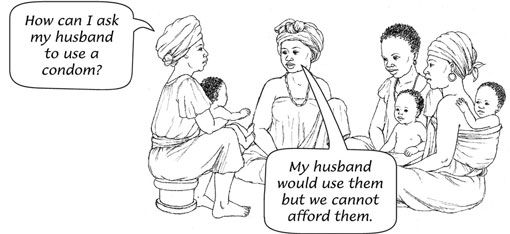25.2.2 Basic steps for community mobilisation
Community mobilisation in general involves certain basic steps that can be applied to HIV/AIDS-related community mobilisation efforts. These steps should be taken into account when preparing any type of community mobilisation to realise significant impact. At each level of the community mobilisation process, full participation of all relevant stakeholders is essential for successful community mobilisation. The basic steps of community mobilisation involve the following features:
Defining the problem
The first step in community mobilisation is to collect the basic information about the issue, in this context the HIV/AIDS epidemic in your community and/or catchment area. This will give you an idea of the extent of the problem and what the underlying causes are. In doing so, you will have a clear statement of the problem and identify the target population in the community affected by it. Traditionally, the most at-risk groups of HIV infection in Ethiopia include female sex workers, uniformed forces, long-distance drivers, migrant labourers and men having sex with men, among others. But it may also include family men who are unfaithful to their wives and will not use condoms, or cannot afford them (Figure 25.2).

Establishing a community mobilisation group
The aim is to establish a group that can influence community mobilisation activities. It usually consists of partners that have a stake in the issue (e.g. PLHIV and/or their families), as well as influential groups and members of the community such as formal and informal leaders and religious and traditional leaders.
Designing strategies, setting objectives and selecting target groups
To achieve a planned change at community level, resources need to be mobilised from the community and other external partners. After obtaining resources, the community mobilisation group should design strategies to address the identified problem with objectives that are SMART, which means Specific, Measurable, Achievable, Relevant and Time-bound. The objectives should be assessed for their impact on the targeted groups in the community.
Developing an action plan with a time line
An action plan links the general community mobilisation plan with time lines for the actual implementation of the planned activities, and the deadlines set for goals to be achieved. This enables the progress of activities to be monitored against the targets set during the planning phase.
Building capacity
Capacity building involves identifying existing capacity resources and assessing the gaps that exist to implement the community mobilisation. The gaps identified should be supplemented by capacity building of the community groups and other relevant stakeholders in the community involved in community mobilisation.
Identifying partners
In the community there are various partners that work independently to achieve similar goals. Therefore, it is important to identify relevant partners through a simple mapping exercise. With respect to prevention and control of HIV/AIDS, for instance, the following partners may be relevant: religious institutions, local non-governmental organisations (NGOs), kebele forums, maheber, idir, woreda HIV/AIDS Prevention and Control Office (HAPCO).
Implementing the plan of activities
Based on the action plans developed with all of the relevant community level partners, implementation of the community mobilisation activities is the main task. In the implementation process, a clear role for any partners that are involved should be put in place and communicated with all of them.
Monitoring and evaluation
Monitoring and evaluation is the last, but essential, element of community mobilisation. It enables you to check whether the action plan has been implemented effectively and the specific objectives are met with respect to the issue the community is mobilised to achieve.
25.2.1 What is community mobilisation?
